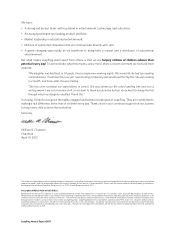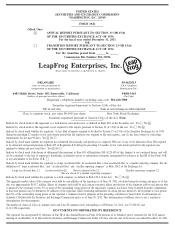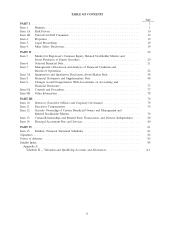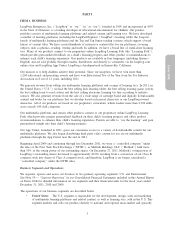LeapFrog 2011 Annual Report Download - page 15
Download and view the complete annual report
Please find page 15 of the 2011 LeapFrog annual report below. You can navigate through the pages in the report by either clicking on the pages listed below, or by using the keyword search tool below to find specific information within the annual report.
greater brand recognition and substantially greater financial, technical and marketing resources than we do.
Our principal competitors in the toy industry have included Mattel, Inc., primarily under its Fisher-Price
brand, Hasbro, Inc. and its Playskool division, and Vtech Holdings Ltd. For information on how competition
could affect our business, see Part I, Item 1A. — Risk Factors — ‘‘If we are unable to compete effectively with
existing or new competitors, our sales and market share could decline.’’
Our products must also compete for the leisure time of children and the discretionary spending of parents with
other forms of media and entertainment. We design our products to bring fun to learning in order to compete
favorably with these outside competitive influences.
Manufacturing
We are committed to designing and manufacturing products that meet applicable safety and regulatory
requirements. As is the case with most toy manufacturers and many consumer electronics companies, most of
our products are manufactured in China. We actively manage our supplier base, mandating compliance with
U.S. and international safety inspections and reinforcing our product standards. Our standards require that we
meet or exceed all applicable regulatory requirements regarding safety in the design, manufacture, packaging,
and delivery into the hands of each product’s ultimate user, a child.
Our manufacturing and operations strategy is designed to maximize the use of outsourced services,
particularly with respect to the actual production and physical distribution of our products. We outsource
substantially all of our manufacturing, using several Asia based manufacturers, most of which manufacture our
products at facilities in the Guangdong province in the southeastern region of China. These manufacturers are
selected based on their technical and production capabilities and are matched to particular products to achieve
cost and quality efficiencies. We depend on these manufacturers to produce sufficient volumes of our finished
products in a timely fashion, at satisfactory cost and quality levels and in accordance with our and our
customers’ terms of engagement. Commodity and labor costs in China continue to increase due to a variety of
factors. For information on the potential business risk resulting from our reliance on contract manufacturers,
see Part I, Item 1A. — Risk Factors — ‘‘We rely on a limited number of manufacturers to produce our
finished products, and our reputation and operating results could be harmed if they fail to produce quality
products in a timely and cost-effective manner and in suffıcient quantities or if our manufacturing process is
otherwise disrupted.’’
We have established subsidiaries in Hong Kong and Shenzhen, China to work closely with our contract
manufacturing service providers. These subsidiaries manage product design, the supply of raw materials, labor
and the assembly process.
Most of our products are manufactured from basic raw materials such as plastic and paper, and a majority of
our products require electronic components. These raw materials are readily available from a variety of
sources, but may be subject to significant price fluctuations. Some of the electronic components used to make
our products, including our application-specific integrated circuits (‘‘ASIC’’), currently come from single
suppliers. For information as to how this concentration of suppliers could affect our business, see Part I,
Item 1A. — Risk Factors — ‘‘We depend on our suppliers for our components and raw materials, and our
production or operating margins would be harmed if the cost of our raw materials were to significantly
increase or if these suppliers are not able to meet our demand and alternative sources are not available.’’
Our quality control system processes include product testing and verification for safety and reliability, starting
in the design phase of a product’s life cycle and continuing through production and field support. We set
standards for supplier performance and we make routine assessments of and take steps to verify compliance
with our quality standards. We communicate those expectations to our suppliers regularly and work with them
to sustain the process of consistently producing safe products. We work with a relatively small group of
contract manufacturers, some of which are specialized for the consumer electronics manufacturing sector. For
more information about the adverse effects that could result from possible errors or defects in our products,
see Part I, Item 1A. — Risk Factors — ‘‘Any errors or defects contained in our products, or our failure to
comply with applicable safety standards, could result in recalls, delayed shipments, rejection of our products
and damage to our reputation, and could expose us to regulatory or other legal action.’’
5
























